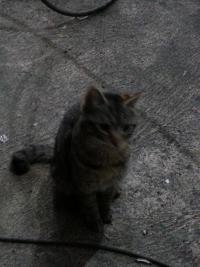DIY Touch Probe & Ohmic Sensor Replacement
- Plasmaguy
-
 Topic Author
Topic Author
- Offline
- Senior Member
-

Less
More
- Posts: 76
- Thank you received: 9
19 Apr 2018 15:21 - 19 Apr 2018 15:27 #109298
by Plasmaguy
DIY Touch Probe & Ohmic Sensor Replacement was created by Plasmaguy
Tommylight's Z axis floating head youtube video
I recently built a DIY plasma table mostly from scratch with a floating torch built from a drawer slide, somewhat similar to what I once saw on Tommylight's youtube video.
One of the chief difficulties for my version of a floating Z has been getting a good, reliable Z index. I've tried micro switches and ohmic probes with rather mediocre success.
With the two different ohmic sensor style probe indexing units; one never worked out of the box despite the manufacturer's assurances his unit was "indestructible" and the second unit i purchased from another manufacturer worked for about a month before it died. I did 5 years of commercial fire alarm and electrical work and I'm confident to say that I was likely not the cause of the problem with either unit. They both ran in the $75 dollar range. Without naming either of their names, the one that did work had it's limitations, namely that it was useless anytime the probe hit a rust bloom or anywhere there was heavy mill oil on whatever sheet or plate I was cutting. This resulted in having to babysit the table to deal with indexing issues on dirty metal.
The micro switches ended up getting smashed a few times, mostly due to my error as an operator. Another issue is having a switch offset, ultimately it eats time out of production which is counterproductive due to excess Z travel.
In response to my mini crisis I devised a very simple and cheap contactor that separates when the floating Z touches the metal. Assembly requires proficiency in welding or possibly another method of assembly could be devised.
It is built from 3 steel bolts with corresponding nuts, a nylon washer as an insulator and 1 or 2 steel washers that sit on top of the nylon washer which act as one half of the isolated contact. A a small piece of angle with a hole drilled through it is needed to mount the contactor assembly to the drawer slide assembly. The nylon and steel washers are glued to the top of the piece of angle to secure the bolt in place.
The two small bolts are #8's which I welded to each contact. The large bolt plays the role of separating the contacts when the torch itself contacts the metal being cut.
The nut for the large bolt must have a nylon insert, the nut is threaded on backwards just far enough that the bolt does not come in contact with the metal part of the nut itself, only the insert. The nut is now electrically isolated from the bolt it is attached to. It helps to first thread the nut on as you normally would until it extends thru the entire nut thereby threading the nylon insert. Then take the nut back off and carefully thread the nut on until just before the bolt contacts the metal part of the nut. It is important that the bolt is threaded into the nylon insert so it sits flat when against the washer for accurately repeatable probing.
This setup has resulted in a very accurate and repeatable indexing method for me. It somewhat follows the same principle as an ohmic sensor but without its limitations, and without having a switch offset as you would with a micro switch. It is powered by one pair of wires to the breakout board in the fashion of a micro switch. When properly built the contacts are isolated from the rest of the table so the BOB is safe.
One of the chief difficulties for my version of a floating Z has been getting a good, reliable Z index. I've tried micro switches and ohmic probes with rather mediocre success.
With the two different ohmic sensor style probe indexing units; one never worked out of the box despite the manufacturer's assurances his unit was "indestructible" and the second unit i purchased from another manufacturer worked for about a month before it died. I did 5 years of commercial fire alarm and electrical work and I'm confident to say that I was likely not the cause of the problem with either unit. They both ran in the $75 dollar range. Without naming either of their names, the one that did work had it's limitations, namely that it was useless anytime the probe hit a rust bloom or anywhere there was heavy mill oil on whatever sheet or plate I was cutting. This resulted in having to babysit the table to deal with indexing issues on dirty metal.
The micro switches ended up getting smashed a few times, mostly due to my error as an operator. Another issue is having a switch offset, ultimately it eats time out of production which is counterproductive due to excess Z travel.
In response to my mini crisis I devised a very simple and cheap contactor that separates when the floating Z touches the metal. Assembly requires proficiency in welding or possibly another method of assembly could be devised.
It is built from 3 steel bolts with corresponding nuts, a nylon washer as an insulator and 1 or 2 steel washers that sit on top of the nylon washer which act as one half of the isolated contact. A a small piece of angle with a hole drilled through it is needed to mount the contactor assembly to the drawer slide assembly. The nylon and steel washers are glued to the top of the piece of angle to secure the bolt in place.
The two small bolts are #8's which I welded to each contact. The large bolt plays the role of separating the contacts when the torch itself contacts the metal being cut.
The nut for the large bolt must have a nylon insert, the nut is threaded on backwards just far enough that the bolt does not come in contact with the metal part of the nut itself, only the insert. The nut is now electrically isolated from the bolt it is attached to. It helps to first thread the nut on as you normally would until it extends thru the entire nut thereby threading the nylon insert. Then take the nut back off and carefully thread the nut on until just before the bolt contacts the metal part of the nut. It is important that the bolt is threaded into the nylon insert so it sits flat when against the washer for accurately repeatable probing.
This setup has resulted in a very accurate and repeatable indexing method for me. It somewhat follows the same principle as an ohmic sensor but without its limitations, and without having a switch offset as you would with a micro switch. It is powered by one pair of wires to the breakout board in the fashion of a micro switch. When properly built the contacts are isolated from the rest of the table so the BOB is safe.
Last edit: 19 Apr 2018 15:27 by Plasmaguy.
The following user(s) said Thank You: tommylight, rodw
Please Log in or Create an account to join the conversation.
- andypugh
-

- Offline
- Moderator
-

Less
More
- Posts: 19752
- Thank you received: 4584
26 Apr 2018 12:03 #109645
by andypugh
Replied by andypugh on topic DIY Touch Probe & Ohmic Sensor Replacement
I would be a little nervous about the long-term conductivity of the steel bolt contacts.
A bit of consideration of the problem at-hand made me wonder if car contact-breaker points could be used as a high-reliability, long-travel switch:
www.ebay.co.uk/itm/191410617105 as an example.
A bit of consideration of the problem at-hand made me wonder if car contact-breaker points could be used as a high-reliability, long-travel switch:
www.ebay.co.uk/itm/191410617105 as an example.
Please Log in or Create an account to join the conversation.
- Mike_Eitel
-

- Offline
- Platinum Member
-

Less
More
- Posts: 1052
- Thank you received: 183
26 Apr 2018 16:51 #109670
by Mike_Eitel
Replied by Mike_Eitel on topic DIY Touch Probe & Ohmic Sensor Replacement
Hi, i have no glue of plasma, but a bit of automation.
I asume you need dista measure only when no spark is ignited.
So why not use normal capacity sensor. Will they die by nearby sparks?
m5c
Mike
I asume you need dista measure only when no spark is ignited.
So why not use normal capacity sensor. Will they die by nearby sparks?
m5c
Mike
Please Log in or Create an account to join the conversation.
- Plasmaguy
-
 Topic Author
Topic Author
- Offline
- Senior Member
-

Less
More
- Posts: 76
- Thank you received: 9
04 Jan 2019 02:51 #123449
by Plasmaguy
Replied by Plasmaguy on topic DIY Touch Probe & Ohmic Sensor Replacement
I just wanted to follow up with my experience... this method of torch indexing has been working flawlessly for almost a year now with near daily use and hundreds of pierces per day.
I just bought a new Z axis with 100mm travel off eBay for $50 and will be looking for a way to recreate the same concept, perhaps executed better on the new Z.
I just bought a new Z axis with 100mm travel off eBay for $50 and will be looking for a way to recreate the same concept, perhaps executed better on the new Z.
The following user(s) said Thank You: tommylight
Please Log in or Create an account to join the conversation.
Moderators: snowgoer540
Time to create page: 0.070 seconds
